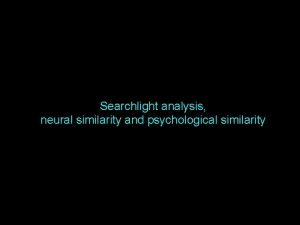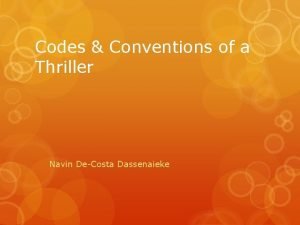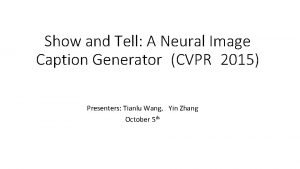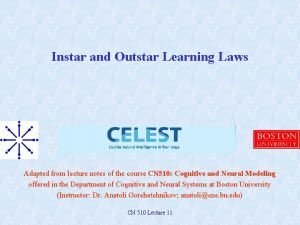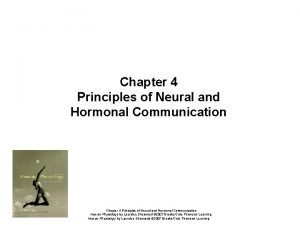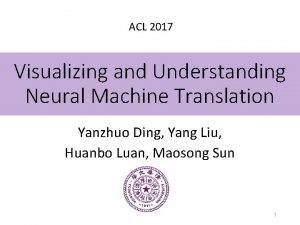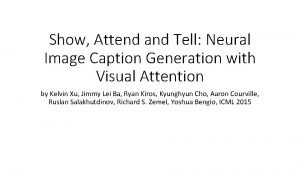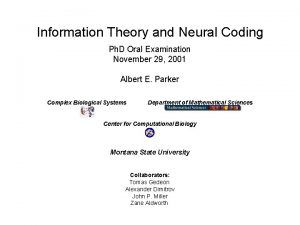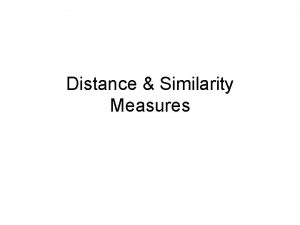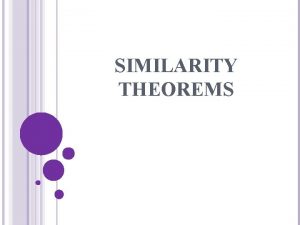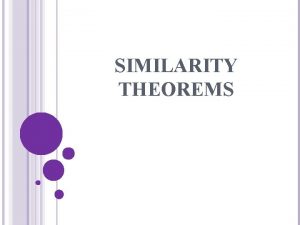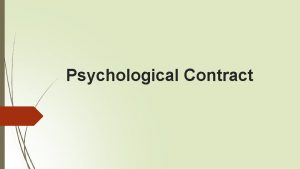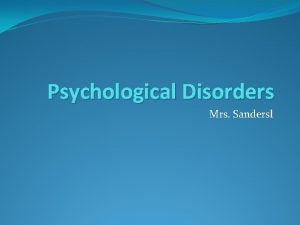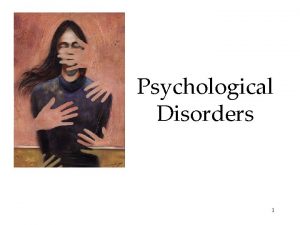Searchlight analysis neural similarity and psychological similarity 1


















- Slides: 18

Searchlight analysis, neural similarity and psychological similarity 1

Standard f. MRI analysis: what is the number inside each voxel? Raw data: BOLD MRI signal Analysis output: activation in each voxel BUT: What we care about: task-relevant information within each voxel 2

Looking at the patterns in a local spatial neighbourhood: Information-based brain imaging Kriegeskorte et al. , PNAS, 2006 Instead of analyzing one voxel at a time, look at spatial patterns of activity in local neighbourhood • “Sphere of information” • No spatial smoothing: that wipes out local patterns The number in each voxel is not an activation value It is how much information is present 3

Searchlight analysis Pull out a local neighbourhood BOLD image Look at the patterns in that neighbourhood 4

Result: a map of information values Searchlight map made at single-subj level At group level, look for average effects across subjects, just like any other group average Very popular approach 5

Searchlight analysis: Advantages and disadvantages Pros: • Different conditions may yield pattern differences without average-intensity differences • Standard analysis (General Linear Model, GLM) will be blind to such differences, searchlight might see them Cons: • You still just end up with a map as output • A map of where stuff is happening might not tell anything about mechanisms or representations 6

Brain images don’t directly show representations. But they can reveal structure Most neuroimaging is massively univariate • Individual voxel activations just go up and down A multivariate approach • Multivoxel patterns have a similarity structure • Searchlight analysis doesn’t directly look at similarity structure • Another approach (also due to Kriegeskorte!): Representational Similarity Analysis 7

Representations have structure From Tom Griffiths et al. , Trends in Cog Sci, 2010 8

Representations have structure From Tenenbaum et al. , Science, 2011 9

Why care about similarity? Neural point of view: • Simple measures of neural similarity, e. g. correlation between f. MRI patterns, can be surprisingly good at decoding content Behavioural point of view: • Similarity underlies generalisation • “Consequential region” – Roger Shepard Computational point of view: • Similarity is an efficient way of representing the world 10

Shimon Edelman: “Representation is representation of similarities” 11

Representing in terms of similarities can be efficient What is a grapefruit? • A grapefruit is a large fruit of the citrus family, with internal segments arranged a bit like longitude regions in the Earth, growing in warm climates, etc. … • It’s a bit like a big orange, but yellow and sourer 12

Similarity in which sense? Is a gun similar to a banana? • Visual similarity: yes • Functional similarity: no “Similarity” in itself is poorly defined • But in “similarity in a given sense” can be well-defined • Lots of relational concepts are like this, e. g. “to the left” 13

Similarity: Shepard vs. Tversky Roger Shepard: • Similarity can be represented by positions in a space • Similarity is like a distance measure • Symmetric: Similarity(A, B) = Similarity(B, A) Amos Tversky • Similarity is more like set-overlap than like positions in a space • May not be symmetric • Example: How similar is Luxembourg to France? • How similar is France to Luxembourg? 14

Similarity-space The set of pairwise similarities between items, as defined by some similarity-measure (or dissimilarity-measure) Dissimilarities between A, B and C A A 0 B 1 C 5 B 1 0 4 C 5 4 0 A B C 15

Similarity-space: a long history in Cog Psych and Computer Science Roger Shepard (1962), John Kruskal (1964) • Multidimensional scaling (MDS) • Takes a set of similarities, and represents them as the best-fitting lower-dimensional projection Computer vision, visual psychophysics • “Representation is representation of similarities”, Shimon Edelman (1998) Olfaction • Cleland, Sobel, Gottfried Computational analysis of language • Latent semantic analysis (LSA). Landauer et al. • Topic modeling (Griffiths, Steyvers, etc. ) 16

Univariate measures just go up or down, but multivariate patterns have similarity structure Shepard, R. N. Toward a universal law of generalization for psychological science. Science, 1988 Kiani et al, J. Neurophys. , 2007; Kriegeskorte et al. , Neuron, 2008

Neural similarity-spaces can be very informative Kriegeskorte, Kiani et al. , Neuron, 2008 18
 Searchlight analysis
Searchlight analysis Define psychological criticism
Define psychological criticism Freedom writers critical analysis
Freedom writers critical analysis Kennesaw state university counseling
Kennesaw state university counseling Thriller genre conventions
Thriller genre conventions Visualizing and understanding convolutional neural networks
Visualizing and understanding convolutional neural networks Show and tell a neural image caption generator
Show and tell a neural image caption generator Deep neural networks and mixed integer linear optimization
Deep neural networks and mixed integer linear optimization Fig 19
Fig 19 Endocrine system pearson
Endocrine system pearson Neural networks and learning machines 3rd edition
Neural networks and learning machines 3rd edition Instar and outstar in neural network
Instar and outstar in neural network Neural and hormonal communication
Neural and hormonal communication Neural networks for rf and microwave design
Neural networks for rf and microwave design Visualizing and understanding neural machine translation
Visualizing and understanding neural machine translation Show, attend and tell
Show, attend and tell Fuzzy logic lecture
Fuzzy logic lecture Neural networks and learning machines
Neural networks and learning machines Information theory and neural coding
Information theory and neural coding
